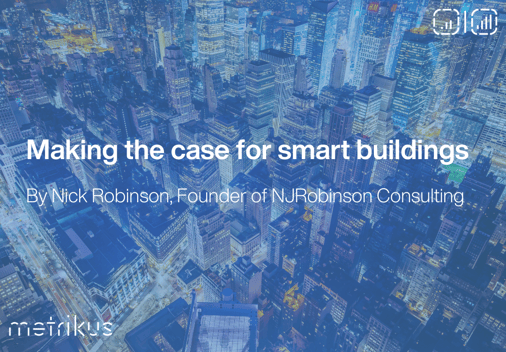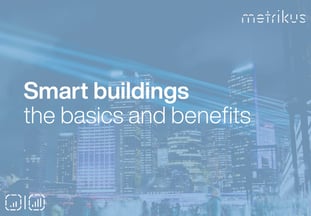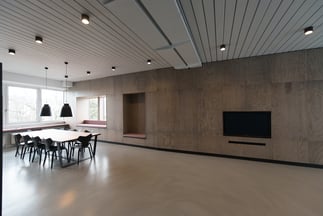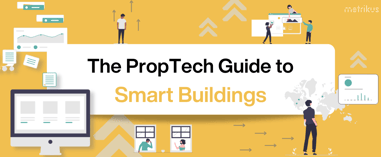Making the case for smart buildings
 Nick Robinson is an experienced Founder and Co-Founder who has been in the IT industry for 25 years. Nick enjoys helping his clients to embrace new technologies to meet desired business outcomes, and is skilled in Sales, Consulting, Professional Services, Management and Software as a Service (SaaS). When Nick is not working, he enjoys time with his family and pretty much any sport that requires good fitness and has a healthy dose of competition (not too much though). Nick is also a NLP Practitioner.
Nick Robinson is an experienced Founder and Co-Founder who has been in the IT industry for 25 years. Nick enjoys helping his clients to embrace new technologies to meet desired business outcomes, and is skilled in Sales, Consulting, Professional Services, Management and Software as a Service (SaaS). When Nick is not working, he enjoys time with his family and pretty much any sport that requires good fitness and has a healthy dose of competition (not too much though). Nick is also a NLP Practitioner.
There is so much great technology out there, the smart buildings industry is maturing and price points are coming down. However, lots of companies are still slow to make their buildings smart.
Why is this? It all boils down to the challenges surrounding making a successful business case.
Taking an outcome-based approach
As part of my work with clients, I’ve noticed that when companies are selling smart building solutions, there is often a focus on how the various technologies work and how they can be integrated into business processes. This focus needs to shift to the actual outcomes of adopting smart technology, especially the actual value that it will provide.
In my view, there are four key questions that companies should ask themselves before they even think about making their buildings smart:
- Will it save us money and what is the ROI/payback?
- Will it support us in generating new revenue or keep existing revenues and how?
- Will it protect or enhance our brand in the market?
- Does it help with complying with current or future regulations and how?
It all boils down to understanding the overall impact of smart on every aspect of a business.
Getting started with a solid business case
I feel very strongly that companies should never test IoT for the sake of testing. There is no point doing a pilot to check if the technology works – this is for the hardware provider to do. The real test is whether your business can use that data to get the results you need for your specific use case.
My advice is to start with a narrow use case that has a very solid business case. A great example of this, especially at the moment, is energy monitoring.
The cost of energy is two, three, four – maybe even five – times more than it was eight months ago. This is having a huge effect on business, which means that reducing consumption is a key priority with a significant saving opportunity.
In at least one in five buildings, the cooling is fighting against the heating and a huge amount of energy is used outside of operating hours. With the right smart technology in place, companies will quickly get the insights they need to reduce consumption.
This is the perfect way to start adopting smart technology, as companies will immediately see both the financial and environmental impact. And once the initial investment in smart infrastructure has been justified with a strong business case, it can then be leveraged for other use cases at a fraction of the post.
I am seeing lots of valuable use cases around the digital world meeting the physical world. For example, essential insights can be delivered on building usage, flow and engagement. Retailers can get the insights for better product placement, landlords can optimise their offering, and tenants can drive space optimisation as well as employee productivity.
Addressing all stakeholders
When it comes to buildings, you are dealing with lots of different stakeholders: facilities managers, financial directors, operation managers, the list goes on. This means that when you create a business case, you need to do so with all of these stakeholders in mind.
You can’t just pick one particular stakeholder – you should engage each one with facts and figures that are relevant to them so that they feel as though they’re getting their slice of the pie, so to speak.
It is also really important to use language that speaks to them. If you fall into the trap of using smart building jargon, people will immediately switch off. Talk about things that matter: business processes, optimization and cost savings, not IoT, CO2 and PPM.
It's the responsibility of smart building technology providers to demystify the language and make things convincing and easy to understand.
Getting finance on board
While I believe that engaging all stakeholders is incredibly important, getting someone from the finance department on board is perhaps the most vital part of the process. It’s all about approaching IoT like a finance person – if I spend X, what will I get in return?
In a lot of cases, companies seem to get dumped information and they then have to try and figure out the real ROI for themselves. If you engage the finance team at an early stage, you can start mapping the actual value of the project. This ensures that you can provide real facts and figures rather than vague percentages and guesstimates.
Engaging teams can be a lengthy and sometimes challenging process up front, but I can guarantee it will be worth it to build a really compelling business case.
Aligning with brand and purpose
The final part of the puzzle is thinking about the bigger purpose behind technology adoption: the why.
The best way for companies to look at this is to work out what they value and what they are already trying to be as a brand. Do they want to be a sustainable brand, a smart brand, a brand that is cutting edge and ahead of the curve?
You can’t just shoehorn a purpose that fits the technology, it needs to come from above and already be integrated into the company.
The most common one at the moment seems to be sustainability. However, it’s vital that there is a level of granularity with definitive goals and targets rather than just a desire to be ‘greener’.
Companies that have a real purpose around sustainability – combined with a clear financial case – are the ones who will see the biggest benefit from smart building solutions.
Making the case for smart buildings
Smart building technology is getting increasingly advanced, sophisticated and complicated, but making the case for smart buildings is relatively simple.
Start with a narrow use case, engage all stakeholders, and ensure that the outcome aligns with the company’s wider strategy and purpose.
If you focus on the actual outcomes of smart building solutions, adopting the technology is the easy part! Good luck…




